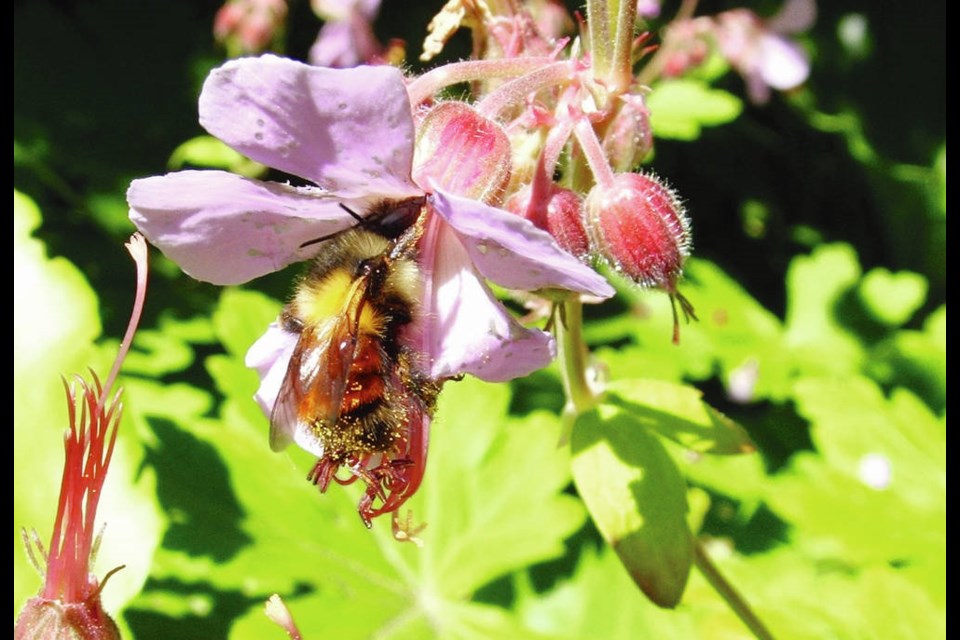Dear Helen: My garden’s soil dried alarmingly fast in the hot, dry weather this month. I’m wondering now whether months of heat and drought lie ahead, just as I’m extending a perennial and a herb garden. Are there ways to drought-proof plants? Can you recommend plants that tolerate drought?
P.E.
The very best protection for plants against drought is a humus-rich, moisture-retentive soil. Preparing a soil before planting with generous additions of a nutritious compost, home-made or purchased, and/or well-composted manures helps to create a spongy soil that fosters a lively community of beneficial micro-organisms, which in turn act to support plant health.
Mulching is a useful secondary protective measure. As air and soil temperatures warm significantly, usually in late spring or early summer, give a target area a long, slow, deep watering, preferably in the early morning, then mulch around the plants with more good quality compost or topsoil.
In vegetable plots, I top the compost mulch with a sun-deflecting material such as straw. Shallow layers of grass clippings, alone or mixed with aged sawdust or fine wood shavings, are also used as mulching materials that help to prevent the soil from losing moisture and over-heating.
Even the most drought tolerant plants need regular watering for the first year, as they develop strong root systems.
Among herbs, the most drought tolerant are the aromatic Mediterranean ones — lavender, rosemary, thyme, sage, and oregano. They thrive in warmth and full sun.
Among perennials that I know well, three are astonishingly drought tolerant: Epimedium, bigroot geranium, and red valerian.
A big clump of red valerian (Centranthus ruber) emerges every spring and blooms profusely from the top of a hip-high pile of rocks in the hottest corner of the back garden. Don’t ask me how.
Geranium macrorrhizum (bigroot geranium) has aromatic, felt-like leaves and early summer pink flowers that attract bees. The plants form a dense mat that suppresses weeds.
Epimedium (barrenwort, bishop’s hat) creates carpets of decorative foliage even in the shade of and amidst the roots of large trees. The spring flowers are like miniature columbines.
Dear Helen: I’ve enjoyed your photos and descriptions of shallow pots with pansies or violas and small, early bulb flowers. You describe inserting the little bulbs into the soil, between the violas and pansies when you plant the containers in early autumn. How would this work with larger bulbs?
D.S.
You would use deeper pots, and plant the bulbs first, at around a third way down from the top of the pot. Add more potting mix, and plant the pansies or violas on top.
My friend Sallie does this. During a visit to her garden at mid-month I admired a ceramic pot planted with a striking combination of semi-dwarf daffodils and black-striped, bright yellow viola plants. The viola, called Tiger Eye, echoed the daffodil colour while adding a dramatic contrast to it.
Many innovative combinations are possible. Once bulbs to be potted are chosen and the flower colour is known, you’ll find a wide range of colours in violas and pansies to match or contrast with the bulb blooms.
Dear Helen: I’ve not found anyone who can identify an odd plant in my newly acquired garden. It forms a thick mat of small, rounded, near-black leaves and has shiny little buttercup-like yellow flowers starting early in the spring. Can you help?
L.D.
Your plantings are very likely a Ranunculus ficaria called Brazen Hussy. Ranunculus plants are commonly referred to as buttercups.
These are perennials that emerge and flower in the spring and then die down as temperatures warm in summer. Brazen Hussy is a beautiful little plant. Its purple-black leaves contrast distinctly with the small yellow buttercup type flowers.
Because the plants are dormant in summer, they are ideally placed by plants that will fill in the spaces created as top growth disappears. Hostas and ferns are possible companions for this purpose.
Be careful with this plant and monitor it carefully. The clumps can spread rapidly and even aggressively, especially in well-watered gardens. Brazen Hussy and other R. ficaria plants can become invasive.
VHS. The Victoria Horticultural Society is hosting a Zoom meeting on Tuesday from 7 to 8:30 p.m. Pamela Dangelmaier and Elke Wehinger from Botanus, a nursery in Langley, will explore the topic Create a Summer Bulb Spectacular. Non-members can register for $5. To register visit .



